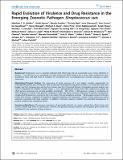Files in this item
Rapid evolution of virulence and drug resistance in the emerging zoonotic pathogen streptococcus suis
Item metadata
| dc.contributor.author | Holden, Matthew T. G. | |
| dc.contributor.author | Hauser, Heidi | |
| dc.contributor.author | Sanders, Mandy | |
| dc.contributor.author | Ngo, Thi Hoa | |
| dc.contributor.author | Cherevach, Inna | |
| dc.contributor.author | Cronin, Ann | |
| dc.contributor.author | Goodhead, Ian | |
| dc.contributor.author | Mungall, Karen | |
| dc.contributor.author | Quail, Michael A. | |
| dc.contributor.author | Price, Claire | |
| dc.contributor.author | Rabbinowitsch, Ester | |
| dc.contributor.author | Sharp, Sarah | |
| dc.contributor.author | Croucher, Nicholas J. | |
| dc.contributor.author | Chieu, Tran Bich | |
| dc.contributor.author | Mai, Nguyen Thi Hoang | |
| dc.contributor.author | Diep, To Song | |
| dc.contributor.author | Chinh, Nguyen Tran | |
| dc.contributor.author | Kehoe, Michael | |
| dc.contributor.author | Leigh, James A. | |
| dc.contributor.author | Ward, Philip N. | |
| dc.contributor.author | Dowson, Christopher G. | |
| dc.contributor.author | Whatmore, Adrian M. | |
| dc.contributor.author | Chanter, Neil | |
| dc.contributor.author | Iversen, Pernille | |
| dc.contributor.author | Gottschalk, Marcelo | |
| dc.contributor.author | Slater, Josh D. | |
| dc.contributor.author | Smith, Hilde E. | |
| dc.contributor.author | Spratt, Brian G. | |
| dc.contributor.author | Xu, Jianguo | |
| dc.contributor.author | Ye, Changyun | |
| dc.contributor.author | Bentley, Stephen | |
| dc.contributor.author | Barrell, Barclay G. | |
| dc.contributor.author | Schultsz, Constance | |
| dc.contributor.author | Maskell, Duncan J. | |
| dc.contributor.author | Parkhill, Julian | |
| dc.date.accessioned | 2014-04-24T14:31:03Z | |
| dc.date.available | 2014-04-24T14:31:03Z | |
| dc.date.issued | 2009-07-15 | |
| dc.identifier | 91766443 | |
| dc.identifier | e0adc00c-386b-442c-b616-0c52eed972e8 | |
| dc.identifier | 000268035700001 | |
| dc.identifier | 67650658074 | |
| dc.identifier.citation | Holden , M T G , Hauser , H , Sanders , M , Ngo , T H , Cherevach , I , Cronin , A , Goodhead , I , Mungall , K , Quail , M A , Price , C , Rabbinowitsch , E , Sharp , S , Croucher , N J , Chieu , T B , Mai , N T H , Diep , T S , Chinh , N T , Kehoe , M , Leigh , J A , Ward , P N , Dowson , C G , Whatmore , A M , Chanter , N , Iversen , P , Gottschalk , M , Slater , J D , Smith , H E , Spratt , B G , Xu , J , Ye , C , Bentley , S , Barrell , B G , Schultsz , C , Maskell , D J & Parkhill , J 2009 , ' Rapid evolution of virulence and drug resistance in the emerging zoonotic pathogen streptococcus suis ' , PLoS One , vol. 4 , no. 7 , e6072 . https://doi.org/10.1371/journal.pone.0006072 | en |
| dc.identifier.issn | 1932-6203 | |
| dc.identifier.other | ORCID: /0000-0002-4958-2166/work/60196500 | |
| dc.identifier.uri | https://hdl.handle.net/10023/4598 | |
| dc.description | This work was supported by the Wellcome Trust. | en |
| dc.description.abstract | Background: Streptococcus suis is a zoonotic pathogen that infects pigs and can occasionally cause serious infections in humans. S. suis infections occur sporadically in human Europe and North America, but a recent major outbreak has been described in China with high levels of mortality. The mechanisms of S. suis pathogenesis in humans and pigs are poorly understood. Methodology/Principal Findings: The sequencing of whole genomes of S. suis isolates provides opportunities to investigate the genetic basis of infection. Here we describe whole genome sequences of three S. suis strains from the same lineage: one from European pigs, and two from human cases from China and Vietnam. Comparative genomic analysis was used to investigate the variability of these strains. S. suis is phylogenetically distinct from other Streptococcus species for which genome sequences are currently available. Accordingly, similar to 40% of the similar to 2 Mb genome is unique in comparison to other Streptococcus species. Finer genomic comparisons within the species showed a high level of sequence conservation; virtually all of the genome is common to the S. suis strains. The only exceptions are three similar to 90 kb regions, present in the two isolates from humans, composed of integrative conjugative elements and transposons. Carried in these regions are coding sequences associated with drug resistance. In addition, small-scale sequence variation has generated pseudogenes in putative virulence and colonization factors. Conclusions/Significance: The genomic inventories of genetically related S. suis strains, isolated from distinct hosts and diseases, exhibit high levels of conservation. However, the genomes provide evidence that horizontal gene transfer has contributed to the evolution of drug resistance. | |
| dc.format.extent | 17 | |
| dc.format.extent | 1227195 | |
| dc.language.iso | eng | |
| dc.relation.ispartof | PLoS One | en |
| dc.subject | RB Pathology | en |
| dc.subject | SDG 3 - Good Health and Well-being | en |
| dc.subject.lcc | RB | en |
| dc.title | Rapid evolution of virulence and drug resistance in the emerging zoonotic pathogen streptococcus suis | en |
| dc.type | Journal article | en |
| dc.contributor.institution | University of St Andrews. School of Medicine | en |
| dc.contributor.institution | University of St Andrews. Infection Group | en |
| dc.contributor.institution | University of St Andrews. Biomedical Sciences Research Complex | en |
| dc.identifier.doi | 10.1371/journal.pone.0006072 | |
| dc.description.status | Peer reviewed | en |
This item appears in the following Collection(s)
Items in the St Andrews Research Repository are protected by copyright, with all rights reserved, unless otherwise indicated.

